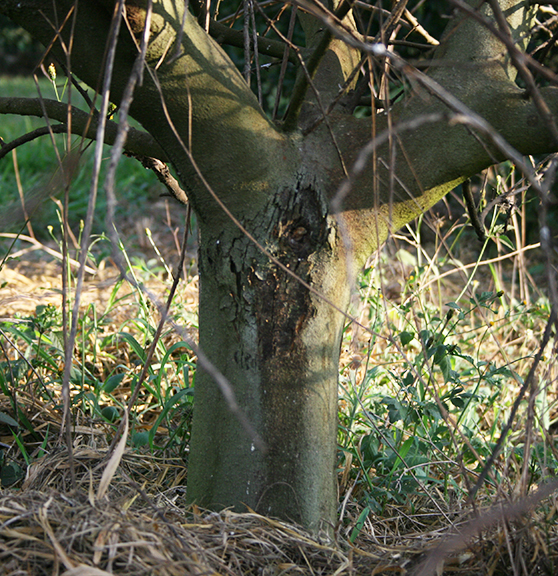Disease Identification
Diseases represent a serious threat to the Florida citrus industry. Management strategies are different for various diseases whether it be fungal, bacterial or viral, therefore, proper identification is imperative.
-
Alternaria Brown Spot
A list of EDIS articles with regard to Alternaria Brown Spot. Use these articles to help manage this disease.
- Alternaria Brown Spot
- Florida Citrus Pest Management Guide: Alternaria Brown Spot
- Quick Reference Guide to Foliar Fungicides
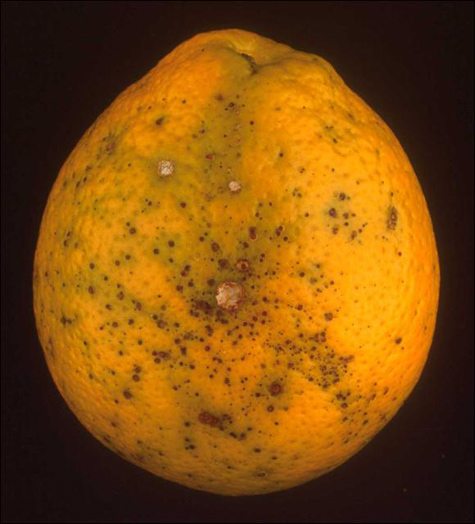
Life Cycle of Alternaria Alternata
-
Black Spot
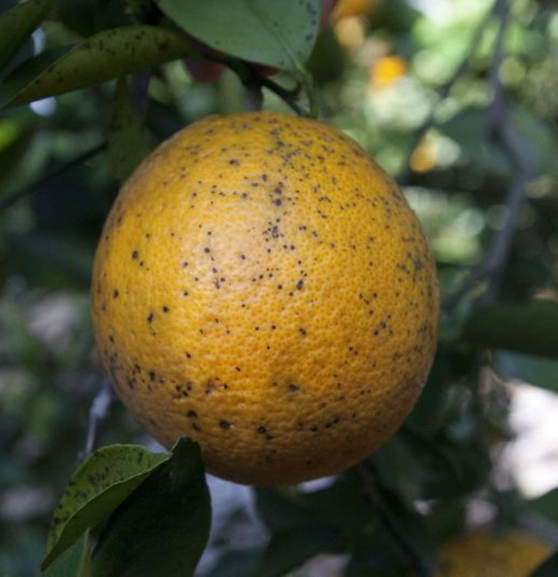
History of Citrus Black Spot
Citrus black spot, caused by the fungal pathogen Guignardia citricarpa (sexual stage) and Phyllosticta citricarpa (asexual stage), was first found in south Florida in March 2010. The initial find was contained to a 15 mile area centered in south Florida near Immokalee. By the first week of May, the disease has been found in another location about 14 miles northeast from the original find. It is expected to be found in additional areas when the new harvest season begins in the fall.
Around the world, black spot can be found in Argentina, Australia, Brazil, China, Ghana, Mozambique, Philippines, South Africa, Sub-Saharan Africa, Taiwan and other regions of South America.
Fruit Symptoms
Black spot symptoms occur in several forms called hard spot, cracked spot, false melanose and virulent spot which are described below.
Hard spot is the most common and diagnostic symptom. The lesions are small, round, sunken with gray centers and brick-red to chocolate brown margins. Green halos are often seen around hard spot lesions. Fungal structures appear as slightly elevated black dots in the center of lesions. They appear as fruit begins to color where light exposure is greatest.
False melanose is observed as numerous small, slightly raised lesions that can be tan to dark brown. It may occur on green fruit and does not have pycnidia (fungal structures). False melanose may become hard spot later in the season.
Cracked spot has large, flat, dark brown lesions with raised cracks on their surface. It is thought to be caused by an interaction between the pathogen and rust mites. It occurs on green as well as mature fruit and can become hard spot later in the season.
Early virulent spot, also known as freckle spot, has small reddish irregularly shaped lesions. It occurs on mature fruit as well as post-harvest in storage. It can develop into either virulent spot or hard spot. Virulent spot is caused by the expansion and/or fusion of other lesions covering most of the fruit surface toward the end of the season. Many fungal structures can be found in these lesions.
Severely affected fruit can drop before harvest causing significant yield loss.
Leaf and Stem Symptoms
Leaf and stem symptoms are not as common as fruit symptoms, but can occur when there is insufficient disease control on any cultivar. They are most commonly found on lemons, a very susceptible species.
Lesions begin as small reddish brown lesions that are slightly raised. With age they become round sunken necrotic spots with gray centers and prominent margins that are brick-red to chocolate brown.
Regulations
Stipulations for Movement of Citrus Fruit from EAN Regulated Areas for Citrus Black Spot PDF
Citrus Black Spot Federal Quarantine Order PDF
More information will be added as it becomes available. However, for most up-to-date information from regulatory agencies, please contact the Florida Division of Plant Industry 863-298-7777.
Spread
• Wind-borne ascospores are forcibly ejected from fungal fruiting bodies embedded in leaves in the leaf litter under trees and are carried by air currents, approximately 75 feet (25 meters) from leaf litter.
• Rain splash may also move spores from infected fruit (conidia) and/or leaf litter (conidia and ascospores), but moves the spores only a few inches (centimeters).
• Live leaves that have latent infections (infections that are not visible) are common means of long distance spread. These often are moved as trash in loads of fruit.
• Infected nursery stock is another potential means of spread. This can occur very easily since these latent infections cannot be seen in otherwise healthy-looking trees.
• Leaf litter movement may be either by wind or human activities
• Humans are the main form of long distance movement
Life Cycle of Citrus Black SpotDiagnostics
If you suspect you may have black spot, please contact your local CHRP office for further diagnostic testing.
Management
• Always plant clean, certified nursery stock. Keeping nursery stock clean is much easier with the new covered nursery regulations but black spot is still a threat. This will help prevent movement of black spot and other diseases into newly established grove plantings.
• Increase air flow in grove to reduce leaf wetness where possible. G. citricarpa needs 24-48 hours of leaf wetness for spore germination and infection as do many other fungal diseases.
• Reduce leaf litter on grove floor to decrease ascospore load through enhanced microsprinkler irrigation.
• Fungicides registered for citrus in Florida that have been found effective in other countries:
•Copper products (all formulations have been found to be equivalent)
•Strobilurins fungicides currently approved labels are Abound, Gem and Headline
• The best fungicide application method is with air blast sprayer. Aerial applications are not likely to get adequate canopy penetration for control. It is important that the leaves and fruit are covered with fungicide.
• For enhanced coverage, increase the gallons used to 250 gallons/acre for applications to ensure full coverage.
• Strategies for Effective Eradication of Citrus Black Spot in Collier and Hendry
• Citrus Black Spot Management 1/9/2013
Presentations
Citrus Black Spot (Guignardia citricarpa): Identification, Biology and Control, Megan Dewdney & Natalia Peres (August 2010)
Challenges in the Citrus Black Spot (CBS) Health Management for the Fresh Fruit Market, Eduardo Feichtenberger (August 2010)
Response of FDACS DPI to Citrus Black Spot in Florida, Tim Schubert (August 2010)
APHIS Response to Citrus Black Spot in Florida, Michael Hornyak & Dave Munyan (August 2010)
Citrus Black Spot, Megan M. Dewdney (May 2010)
Citrus Black Spot Diagnostics, Katherine Hendricks and Pamela Roberts (May 2010)
Photo Gallery
... -
Black Spot (continued)
Links
Florida Division of Plant Industry Citrus Black Spot Updates (including maps of quarantine areas) website
USDA Press Release-English PDF
USDA Press Release-Spanish PDF
Florida Division of Plant Industry Pest Alert PDF
Fungicide resistance: Why it happens and how it may affect you. Citrus Industry, March 2010 PDF
Citrus black spot. Citrus Industry, January 2010 PDF
University of Florida, Postharvest website
Resources
If you would like to obtain laminated identification sheets or copies of the other various educational materials, please contact Jamie Burrow, 863-956-8648 or jdyates@ufl.edu
Citrus Black Spot : No longer an exotic disease PDF
Citrus Black Spot ID Sheet PDF
Citrus Black Spot Management Timing Schedule PDF
Citrus Black Spot Poster for Growers (18 x 27) PDF
Citrus Black Spot Poster for Packinghouses (32 x 26) English PDF
Citrus Black Spot Poster for Packinghouses (32 x 26) Spanish PDF
Packinghouse Citrus Black Spot ID PDF
Quick Reference Guide to Foliar Fungicides Quick Reference Guide to Foliar Fungicides
Contacts
Megan Dewdney, Ph.D. Plant Pathologist 863-956-1151 mmdewdney@ufl.edu Natalia Peres, Ph.D. Plant Pathologist 813-633-4133 nperes@ufl.edu Mark Ritenour, Ph.D. Postharvest Physiology 772-468-3922 ritenour@ufl.edu Pamela Roberts, Ph.D. Plant Pathologist 239-658-3400 pdr@ufl.edu Florida Multi-County Citrus Extension Agents - Blight
-
Canker
Canker Update: Where is Canker now?
Jamie YatesCitrus canker has been a serious problem since the last Florida outbreak began in 1995. Numerous residents lost their only tree while commercial growers continue to burn trees on a daily basis due to canker. If you have spoken to any citrus grower or caretaker in the last few months, you will realize that canker is still a threat and we are learning to live with it every day.
It is vital that the citrus industry and Florida residents work together to prevent further spread of citrus canker. It is not a job that can be done by one person or one company but everyone coming together. We must learn about citrus canker and apply basic preventative measures to protect the $9 billion dollar Florida citrus industry.
-
Exotic Citrus Diseases
Exotic Citrus Diseases are NOT found in Florida but if you suspect any of these diseases in your grove, report it! Early detection is essential to protecting Florida Citrus!
-
Greasy Spot
A list of EDIS articles with regard to Greasy Spot. Use these articles to help manage this disease.
- Greasy Spot
- Field Identification and Management of Greasy Spot Disease
- Florida Citrus Pest Management Guide: Greasy Spot
- Quick Reference Guide to Foliar Fungicides
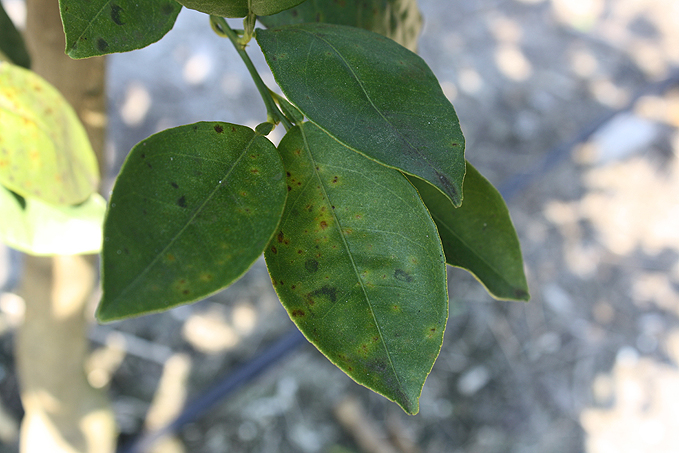
-
Citrus Greening (Huanglongbing)
Huanglongbing (HLB; citrus greening) is thought to be caused by the bacterium, Candidatus Liberibacter asiaticus. HLB has seriously affected citrus production in a number of countries in Asia, Africa, the Indian subcontinent and the Arabian Peninsula, and was discovered in July 2004 in Brazil. Wherever the disease has appeared, citrus production has been compromised with the loss of millions of trees. HLB has not been reported in Australia or in the Mediterranean Basin. In August 2005, the disease was found in the south Florida region of Homestead and Florida City. Since that time, HLB has been found in commercial and residential sites in all counties with commercial citrus.
The early symptoms of HLB on leaves are vein yellowing and an asymmetrical chlorosis referred to as “blotchy mottle.” The blotchy mottle symptom is the most diagnostic symptom of the disease, especially on sweet orange. Leaves may be small and upright with a variety of chlorotic patterns that often resemble mineral deficiencies such as those of zinc, iron, and manganese. Some leaves may be totally devoid of green or with only green islands. The blotchy mottle symptom also may be confused with other diseases or damage such as severe forms of citrus tristeza virus (CTV), Phytophthora root rot, water logging, citrus blight, leafminer tunnels or stubborn, a disease that is not known to be present in Florida. Root systems of infected trees are often poorly developed and new root growth may be suppressed. Early symptoms of yellowing may appear on a single shoot or branch. The yellowing usually spreads throughout the tree over a year, especially on young trees, and affected trees may show twig dieback, causing the productivity to decline within a few years. Fruit are often few in number, small, may be lopsided with a curved central core, and fail to color properly, remaining green at the stylar end. Many fruit drop prematurely from afflicted trees. A yellow stain may be present just beneath the peduncle (stem) on a cut fruit. The affected fruit often contain aborted seeds and have a salty bitter taste.
-
Melanose
A list of EDIS articles with regard to Melanose. Use these articles to help manage this disease
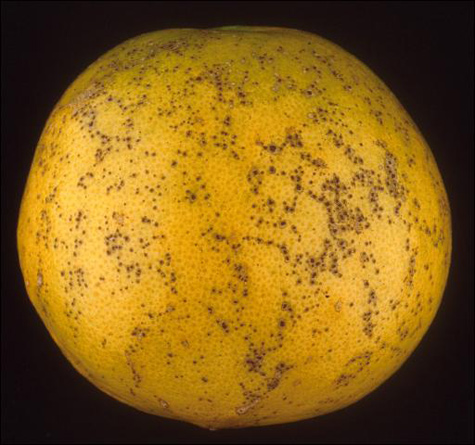
- Phytophthora
-
Postbloom Fruit Drop
A list of EDIS articles with regard to Postbloom Fruit Drop. Use these articles to help manage this problem.
- Florida Citrus Pest Management Guide: Postbloom Fruit Drop
- Quick Reference Guide to Foliar Fungicides Quick Reference Guide to Foliar Fungicides

- Citrus Advisory System
-
Postharvest Diseases
- Postharvest Decay Control Recommendations for Florida Citrus Fruit
- Stem-End Rind Breakdown of Citrus Fruit
- Sour Rot
- Phomopsis Stem-End Rot
- Diplodia Stem-End Rot
- Blue Mold
- Green Mold
- Brown Rot
- Florida Citrus Pest Management Guide: Brown Rot of Fruit
- Pesticide Residues & Maximum Limits
- A Guide to Citrus Disease Identification
- Related Sites
-
Scab
A list of EDIS articles with regard to Citrus Scab. Use these articles to help manage this disease.
- Citrus Scab
- Florida Citrus Pest Management Guide: Citrus Scab
- Quick Reference Guide to Foliar Fungicides
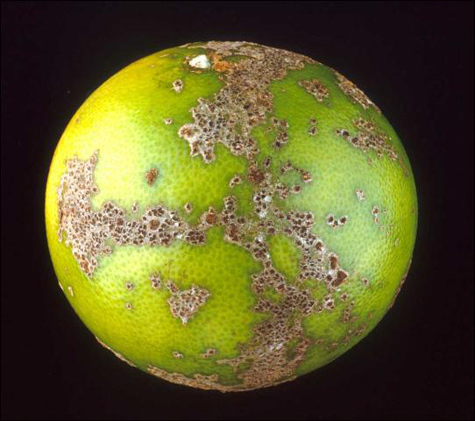
- Tristeza
- Virus-like Diseases

